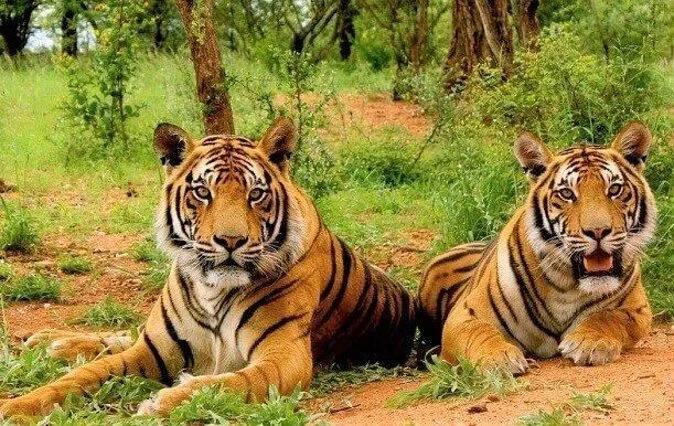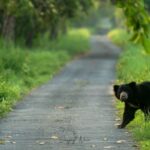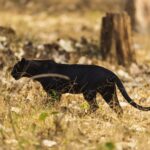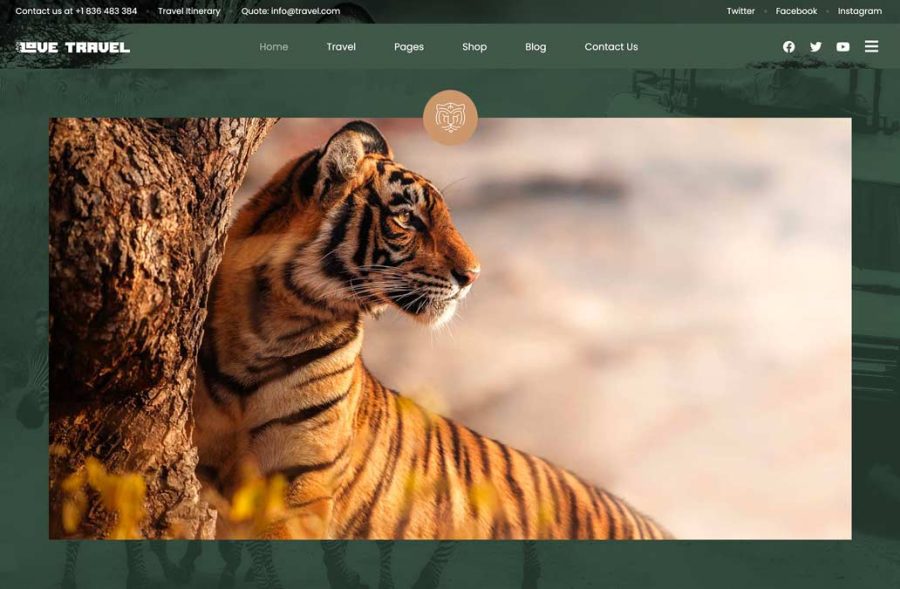Tadoba National Park, located in Maharashtra, India, is a renowned wildlife sanctuary in India known for its rich biodiversity. With its stunning mix of dry deciduous forests, grasslands, and the picturesque Tadoba Lake, the reserve provides the perfect environment for a wide variety of wildlife. The park is most famous for its Bengal tiger population, but it is also home to other members of the “Big Five” such as leopards, sloth bears, Indian bison, and wild dogs. In addition to the mammals, Tadoba is a paradise for birdwatchers, with over 195 species of birds. Visitors can experience the wonders of Tadoba through organized safaris by jeep or on elephant back.
Jump To
ToggleKey Takeaways:
- Tadoba National Park in Maharashtra, India, is a renowned wildlife sanctuary.
- The park is known for its rich biodiversity, including the Bengal tiger population and other members of the “Big Five”.
- Tadoba is also a paradise for birdwatchers, with over 195 species of birds.
- Visitors can explore Tadoba through organized safari in Tadoba by jeep or on elephant back.
- The park offers a unique opportunity to reconnect with nature and experience the beauty of the untamed world.
Witness Majestic Bengal Tigers in Tadoba National Park
Tadoba National Park is renowned for its thriving Bengal tiger population, making it one of the best places in India to spot these majestic creatures in their natural habitat. The park’s rich biodiversity and conservation efforts have contributed to the success of tiger conservation in the region. Visitors to Tadoba have the opportunity to witness these magnificent creatures up close and learn about the importance of wildlife conservation.
At Tadoba National Park, the presence of Bengal tigers is a testament to the park’s commitment to wildlife conservation. These iconic and enigmatic creatures roam freely amidst the diverse ecosystem, captivating the hearts of visitors from around the world. The park’s efforts to protect and preserve their natural habitat have helped in ensuring the survival and growth of the Bengal tiger population.
Through organized safari tours, visitors have the chance to witness the awe-inspiring beauty of Bengal tigers in their natural surroundings. Experienced guides lead the way, offering insight into the behavior and habitat of these majestic creatures. This unique opportunity allows for an understanding of the importance of wildlife conservation and the need to protect these endangered species.
As visitors explore Tadoba National Park, the thrill of encountering a Bengal tiger in the wild is an experience that lingers long in the memory. The raw power and elegance of these creatures leave a lasting impact, deepening the appreciation for their role in maintaining the delicate balance of the ecosystem.
Tiger Conservation at Tadoba National Park
Tadoba National Park is committed to the conservation and protection of Bengal tigers. The park’s dedicated team of rangers and conservationists work tirelessly to monitor the tiger population, study their behavior, and mitigate potential threats. Through initiatives such as habitat restoration, anti-poaching measures, and community engagement, Tadoba National Park aims to ensure a safe and sustainable environment for Bengal tigers to thrive.
The Big Five of Tadoba National Park
Tadoba National Park is not just renowned for its Bengal tigers; it is also home to the other members of the “Big Five” – leopards, sloth bears, Indian bison, and wild dogs. These elusive creatures offer wildlife enthusiasts the thrilling experience of tracking their footprints and observing their natural behaviors in their natural habitat.
Spotting these animals in Tadoba is a humbling and unforgettable experience. Let’s explore each member of the “Big Five” and discover the unique characteristics that make them a crucial part of the park’s rich biodiversity:
Leopards
Scientific Name: Panthera pardus
Leopards are skilled climbers and agile predators known for their stealth and adaptability. With their beautiful spots and powerful build, spotting a leopard in Tadoba is a thrilling sight to behold. These elusive cats are known for their solitary nature and prefer dense vegetation for hunting and resting.
Sloth Bears
Scientific Name: Melursus ursinus
Sloth bears, with their shaggy fur and long claws, are a unique sight in Tadoba National Park. They are primarily nocturnal creatures, feeding on termites and ants, and are famous for their ability to break open termite mounds with their strong jaws. Spotting a sloth bear in Tadoba is truly a sight to cherish.
Indian Bison
Scientific Name: Bos gaurus
Indian bison, also known as gaur, are majestic creatures that command attention with their massive size and impressive horns. These herbivores play a vital role in maintaining the ecological balance of Tadoba National Park. Observing their peaceful graze in the grasslands is a serene experience that showcases the harmony of nature.
Wild Dogs
Scientific Name: Cuon alpinus
Wild dogs, also known as dholes, are highly social and intelligent creatures. They are known for their cooperative hunting strategies and intricate social structures. Seeing a pack of wild dogs in action, with their playful interactions and synchronized movements, is a testament to the wonders of wildlife in Tadoba.
| Species | Scientific Name | Description |
|---|---|---|
| Leopards | Panthera pardus | Skilled climbers and agile predators, with a solitary nature. |
| Sloth Bears | Melursus ursinus | Nocturnal insectivores with shaggy fur and long claws. |
| Indian Bison | Bos gaurus | Majestic herbivores, crucial for maintaining the ecological balance. |
| Wild Dogs | Cuon alpinus | Social, intelligent predators known for their cooperative hunting. |
Birdwatching Paradise at Tadoba National Park
Tadoba National Park is not just famous for its mammals; it is also a haven for birdwatchers. With over 195 species of birds, including the vibrant Indian pitta, crested serpent eagle, and painted francolin, birdwatching in Tadoba is a treat for nature enthusiasts. The melodious symphony of these birds during dawn creates a magical atmosphere that adds to the overall charm of the park.

If you’re a bird lover, Tadoba National Park offers an incredible opportunity to witness the fascinating avian species that call this place home.
Explore the Birdlife in Tadoba
The diverse habitats within Tadoba National Park make it an ideal destination for birdwatching. Whether you’re an amateur birdwatcher or an avid enthusiast, the park’s varied landscapes provide a rich ecosystem for a wide range of avian species.
- Indian Pitta – The Indian pitta, with its colorful plumage and melodious calls, is a must-see for birdwatchers visiting Tadoba. Spotting this elusive bird can be a rewarding and memorable experience.
- Crested Serpent Eagle – Keep an eye out for the majestic crested serpent eagle soaring above the treetops. Its unique appearance and impressive wingspan make it a sight to behold.
- Painted Francolin – Listen for the distinctive calls of the painted francolin as they forage on the forest floor. These beautiful birds are known for their intricate patterning and interesting behavior.
These are just a few examples of the bird species you can encounter during your visit to Tadoba National Park. Each season brings its own set of migratory birds, adding to the already impressive bird population within the park.
Expert Guided Birdwatching Tours
“Birdwatching in Tadoba National Park is a delightful experience, filled with surprises and discoveries. Our expert guides will take you on an immersive journey through the park, helping you identify and learn more about the remarkable birdlife that thrives here.” – Birding Adventures Tadoba
For a more enriching birdwatching experience, consider joining a guided tour led by experienced birding experts. These knowledgeable guides will not only help you spot rare bird species but also provide valuable insights into their behavior and habitat.
Whether you’re a novice birdwatcher or a seasoned pro, Tadoba National Park offers a remarkable birdwatching experience that will leave you in awe of the park’s avian diversity.
Thrilling Safari Adventures at Tadoba National Park
Exploring Tadoba National Park is an adventure in itself. The park offers organized safaris by jeep and on elephant back, allowing visitors to get up close and personal with the wildlife. These safaris provide a unique perspective of the wilderness and offer ample opportunities for wildlife photography. Capturing awe-inspiring photographs of the flora and fauna in their natural habitat is a highlight of the safari experience at Tadoba.
Embark on a thrilling journey through Tadoba National Park and immerse yourself in the untamed beauty of nature. Whether you choose to venture into the heart of the park on a jeep safari or opt for a more traditional elephant-back safari, Tadoba will never cease to amaze. The lush landscapes, dotted with majestic animals, create the perfect backdrop for the perfect wildlife photography shot.
Indigenous Culture and Conservation Efforts at Tadoba National Park
The Gond tribal communities living in the buffer zones of Tadoba National Park have a deep connection with nature and play a crucial role in the conservation efforts of the park. These indigenous communities, with their rich stories, traditions, and knowledge, have woven a tapestry of history that is intricately linked to the park’s existence.
As stewards of the land, their profound understanding of the ecosystem adds a unique charm to Tadoba National Park. The Gond tribal communities have been living harmoniously in close proximity to wildlife for generations. They possess invaluable knowledge about the behavior and habitat of the animals, making their insights vital for the conservation efforts of the park.
“Living in harmony with nature is not just a way of life for us; it is our responsibility. The flora and fauna of Tadoba National Park are part of our cultural heritage, and we are committed to preserving it for future generations.”
– Chief Mando Gond, a tribal elder
The symbiotic relationship between the Gond tribal communities and nature is evident in their conservation practices. They understand the delicate balance required to coexist with wildlife, and their traditional methods of cultivation and resource management prioritize sustainable practices. Through their indigenous wisdom and active participation in conservation initiatives, the Gond tribal communities play a vital role in preserving the unique biodiversity of Tadoba National Park.
The Gond Tribal Communities: Guardians of Tadoba’s Heritage
The Gond tribal communities have developed an intimate understanding of Tadoba National Park over centuries of cohabitation. Their knowledge of the flora and fauna, seasonal patterns, and the behavior of the animals is passed down through generations, ensuring the continuation of this invaluable wisdom.
They have immense respect for the land and the animals that call it home. Their traditional practices, such as sacred groves and nature worship, serve as testament to their deep-rooted connection with nature. The Gond tribal communities have dedicated themselves to safeguarding the park’s pristine beauty while maintaining a delicate balance between the needs of their community and the conservation efforts.
Collaborative Conservation Initiatives
Recognizing the pivotal role played by the Gond tribal communities in the conservation of Tadoba National Park, collaborative initiatives have been established between the indigenous communities, park authorities, and conservation organizations. These initiatives aim to empower the Gond tribal communities, promote sustainable livelihoods, and enhance their active involvement in the protection of the park’s natural heritage.
Training programs and workshops are conducted to enhance their knowledge of conservation practices, sustainable agriculture, and ecotourism. By integrating traditional practices with modern conservation techniques, the Gond tribal communities are at the forefront of creating a sustainable future for Tadoba National Park.
Moreover, the involvement of the indigenous communities in eco-guiding and interpretation services adds a unique dimension to the visitor experience. Tourists have the opportunity to learn from the Gond tribal communities and gain a deeper understanding of the park’s cultural significance along with its ecological value. This synergy between conservation efforts and the preservation of indigenous cultural heritage makes Tadoba National Park a truly remarkable destination.
Preserving Heritage, Enriching Conservation
The Gond tribal communities’ rich cultural heritage and deep affiliation with nature form the bedrock of Tadoba National Park’s conservation efforts. By honoring their traditions and drawing upon their wisdom, the park and its stakeholders foster a sense of collective responsibility towards the preservation of this precious natural ecosystem.
The symbiosis between the Gond tribal communities and Tadoba National Park stands as a testament to the fact that conservation is not only about protecting wildlife; it is about acknowledging and preserving the intricate relationships between humans and the natural world. Together, they shape the future of Tadoba National Park, ensuring the harmony and longevity of this exceptional wildlife sanctuary.
Conservation Efforts by the Gond Tribal Communities
| Conservation Effort | Details |
|---|---|
| Traditional Resource Management | Utilizing indigenous knowledge to sustainably manage natural resources and prevent overexploitation. |
| Conservation Education | Sharing traditional stories and wisdom to raise awareness among community members and visitors about the importance of protecting wildlife and their habitat. |
| Community-Based Ecotourism | Empowering Gond tribal communities to actively participate in eco-tourism ventures, creating sustainable livelihoods and fostering a stronger connection between locals and the natural environment. |
| Conservation Leadership | Encouraging the engagement of Gond tribal communities in leadership roles within conservation organizations and park management, ensuring their voices and perspectives are represented. |
Conservation Challenges at Tadoba National Park
While Tadoba National Park has made significant strides in wildlife conservation, it continues to face numerous challenges. These challenges jeopardize the delicate balance of the ecosystem and require urgent attention to ensure the long-term sustainability of the park.
Habitat destruction is one of the primary concerns at Tadoba National Park. The encroachment of human settlements and the expansion of agriculture pose a significant threat to the natural habitat of several wildlife species. Deforestation and land degradation disrupt the intricate web of life, leading to a decline in biodiversity and the loss of crucial corridors for animal movement.
Poaching is another pressing issue that poses a direct threat to the survival of many endangered species. The illegal trade in animal parts, driven by the demand for exotic products, puts iconic species like the Bengal tiger and Indian bison at risk. Efforts to combat poaching and strengthen wildlife law enforcement are essential to safeguard these vulnerable creatures.
Human-wildlife conflicts are also prevalent in and around Tadoba National Park. As human populations expand and encroach upon wildlife habitats, conflicts arise due to competition for resources, damage to crops, and occasional attacks on humans. Balancing the needs of local communities and the preservation of wildlife becomes crucial in mitigating these conflicts and promoting peaceful coexistence.
Sustainable Solutions: Conservationists and Local Communities Joining Forces
The challenges faced by Tadoba National Park highlight the importance of collaborative efforts in conservation. Conservationists, along with local communities, play a pivotal role in finding sustainable solutions to protect the unique natural heritage of the park.
“Conservation is a collective responsibility. By working together, we can overcome the challenges that threaten Tadoba’s wildlife and ecosystems. Engaging local communities in conservation initiatives and empowering them as stewards of their own land fosters a sense of ownership and ensures the long-term sustainability of these precious resources.”
Conservation efforts encompass a range of activities, including habitat restoration, community-based eco-tourism, and public awareness campaigns. By restoring and protecting critical habitats, such as connectivity corridors and water bodies, the park can ensure the survival and thriving of diverse wildlife populations.
The involvement of local communities in eco-tourism initiatives not only provides livelihood opportunities but also promotes a sense of pride and responsibility towards nature. Sustainable tourism practices ensure that visitors have a minimal impact on the environment while enjoying the park’s natural beauty and biodiversity.
Moreover, raising awareness among the public, both locally and globally, about the importance of conservation and the challenges faced by Tadoba National Park is paramount. Education, outreach programs, and partnerships with educational institutions create a sense of empathy and instill a commitment to protecting the natural world for future generations.

| Conservation Challenges | Status |
|---|---|
| Habitat Destruction | Ongoing |
| Poaching | Persistent |
| Human-Wildlife Conflicts | Prevalent |
Best Time to Visit Tadoba National Park
Planning a visit to Tadoba National Park for safari? Here’s some safari tips about the best time to explore this incredible wildlife sanctuary.
The ideal time to visit Tadoba National Park is between October and March. During these months, the weather is pleasant, with mild temperatures and low humidity, creating comfortable conditions for wildlife sightings and outdoor activities.
The Tadoba safari experience is enhanced during this period as well. The wildlife in the park tends to be more active, increasing the chances of spotting a variety of animals, including the majestic Bengal tigers that Tadoba is famous for.
It is highly recommended to book your Tadoba safari tours in advance to ensure availability. As one of the most popular national parks in India, Tadoba can get crowded, especially during peak seasons. Pre-booking your safari allows you to secure your spot and enjoy a hassle-free adventure.
Visiting Tadoba National Park during the peak season offers numerous advantages, including a higher likelihood of wildlife encounters, optimal weather conditions, and a fully immersive experience in this wildlife paradise.
Don’t miss the opportunity to explore Tadoba National Park during its prime months. Pack your bags, book your safari, and get ready for an unforgettable wildlife adventure in this stunning sanctuary.
Flora and Fauna of Tadoba National Park
Tadoba National Park is a sanctuary that encompasses a diverse range of flora and fauna, creating a rich ecological tapestry. The park’s landscape is dominated by Southern tropical dry deciduous vegetation, which provides a unique habitat for a wide variety of plant and animal species.
The Flora of Tadoba National Park
The park is home to an impressive array of tree species, each contributing to the vibrant ecosystem. From the stately teak trees to the fragrant salai and the graceful bamboo, the forest is a captivating mix of colors and textures. The mahua tree with its beautiful flowers holds cultural significance for the indigenous communities residing in the area.
The Fauna of Tadoba National Park
Tadoba National Park is renowned for its diverse wildlife population, with Bengal tigers taking center stage as the park’s most iconic residents. However, the park is also home to other majestic creatures such as leopards, ensuring an exciting safari experience for wildlife enthusiasts.
In addition to the charismatic mammals, the park is a birdwatcher’s paradise, with a wide variety of avian species calling Tadoba their home. From the vibrant Indian pitta to the graceful crested serpent eagle and the elusive painted francolin, bird lovers will be enthralled by the feathered diversity found within the park.
Reptiles also add to the overall wildlife diversity of Tadoba, with sightings of species such as the Indian python and the monitor lizard providing a glimpse into the fascinating world of reptilian life.
“Tadoba National Park is a treasure trove of biodiversity, showcasing the harmonious coexistence of various flora and fauna species.”
Exploring the flora and fauna of Tadoba National Park not only offers a chance to witness the wonders of nature but also reinforces the importance of preserving such ecosystems for generations to come. The park serves as a reminder of the delicate balance that exists within our natural world and the need to protect it.
Accommodation and Gateway to Tadoba National Park
When planning a visit to Tadoba National Park, finding the right accommodation is crucial for a memorable experience. Fortunately, the park offers a variety of accommodation options to cater to different preferences and budgets. Most of these accommodations are conveniently located near the popular entrance gates of Kolara and Mohurli, providing easy access to the park’s stunning wilderness.
Staying near the Kolara Gate or Mohurli Gate ensures that visitors have a shorter commute to the park and can maximize their time exploring the diverse flora and fauna of Tadoba. These accommodations offer a range of amenities to ensure a comfortable stay, allowing visitors to relax and unwind after a day of exciting wildlife encounters.
| Accommodation Options | Location | Amenities |
|---|---|---|
| Safari Lodges and Resorts | Near Kolara and Mohurli Gates | – Luxurious cottages and tents – Dining facilities serving local and international cuisine – Guided nature walks and birdwatching – Swimming pools and recreational activities |
| Guesthouses and Homestays | In nearby villages | – Authentic cultural experiences with local families – Comfortable rooms with basic amenities – Traditional home-cooked meals – Insightful interactions with indigenous communities |
| Forest Rest Houses | Within the park boundaries | – Immersive experience in the heart of the wilderness – Stay surrounded by pristine nature – Limited facilities for a rustic adventure |
With the choice of these accommodation options, visitors to Tadoba National Park can find the perfect place to relax, rejuvenate, and prepare for each exciting day of wildlife exploration. Whether you prefer a luxurious resort, an authentic homestay experience, or a rustic forest rest house, Tadoba has something to suit every traveler’s needs.
Remember to book your accommodation in advance to secure your preferred choice and make the most of your visit to Tadoba National Park!
Conclusion
Tadoba National Park is a wildlife sanctuary that captivates wildlife enthusiasts and nature lovers alike. With its diverse range of wildlife, including the majestic Bengal tigers and other members of the “Big Five,” Tadoba offers a thrilling opportunity to explore the untamed world. But it’s not just the wildlife that makes Tadoba special; it’s the park’s commitment to conservation efforts that truly sets it apart.
Supported by local communities and conservationists, Tadoba National Park’s conservation efforts aim to preserve its rich biodiversity for future generations. The park serves as a shining example of the importance of protecting and sustaining such natural wonders as wildlife sanctuaries. By visiting Tadoba, visitors not only have the chance to reconnect with nature but also play a part in the ongoing conservation efforts.
Stepping into Tadoba National Park is like entering a paradise where lush vegetation, captivating landscapes, and the thrill of wildlife encounters await. It is a sanctuary where nature thrives, and wildlife conservation is at the forefront. Tadoba is not just a place to experience the wonders of the wild; it is a testament to the power of conservation efforts. Be a part of this incredible journey and witness firsthand the magnificence of Tadoba National Park.
FAQ
What is Tadoba National Park?
Tadoba National Park is a renowned wildlife sanctuary in Maharashtra, India, known for its rich biodiversity and stunning landscapes.
What is the best time to visit Tadoba National Park?
The best time to visit Tadoba National Park is between October and March when the weather is pleasant, and wildlife is more active.
How can I book a Tadoba safari?
You can book a Tadoba safari through authorized tour operators or online booking portals. It is advisable to book in advance as the safaris tend to fill up quickly.
What animals can I see in Tadoba National Park?
Tadoba National Park is home to a variety of wildlife, including Bengal tigers, leopards, sloth bears, Indian bison, and wild dogs, among others.
Can I go birdwatching in Tadoba National Park?
Yes, Tadoba National Park is a paradise for birdwatchers, with over 195 species of birds, including the vibrant Indian pitta and crested serpent eagle.
What safari options are available in Tadoba National Park?
Tadoba National Park offers organized safaris by jeep and on elephant back, allowing visitors to get up close and personal with the wildlife.
What is the significance of the Gond tribal communities in Tadoba National Park?
The Gond tribal communities living in the buffer zones of Tadoba National Park play a crucial role in the conservation efforts of the park and have a deep connection with nature.
What are the conservation challenges at Tadoba National Park?
Tadoba National Park faces ongoing challenges such as habitat destruction, poaching, and human-wildlife conflicts, which threaten the delicate balance of the ecosystem.
What is the flora and fauna like in Tadoba National Park?
Tadoba National Park boasts a diverse range of flora and fauna, with Southern tropical dry deciduous vegetation and various tree species, mammals, birds, and reptiles.
Where can I find accommodations near Tadoba National Park?
There are several accommodations available near the popular entrance gates of Kolara and Mohurli, offering convenient access to the park and safari activities.
What makes Tadoba National Park unique?
Tadoba National Park is unique due to its diverse wildlife, conservation efforts, and the symbiotic relationship between the indigenous communities and nature.



























